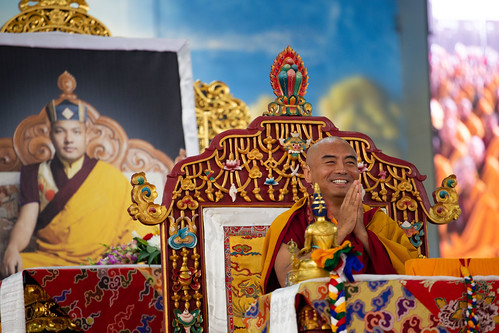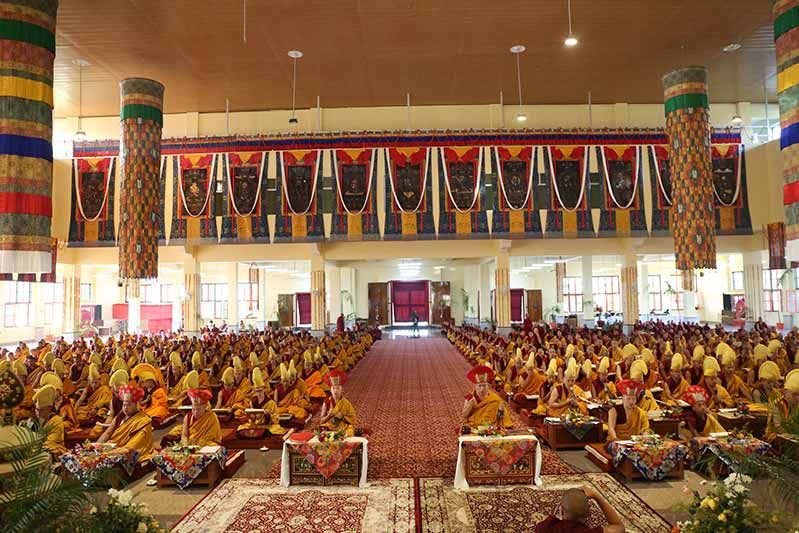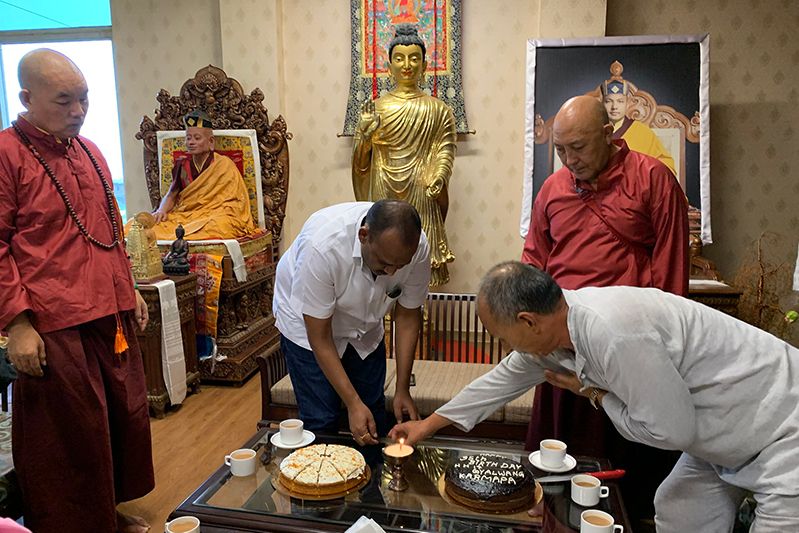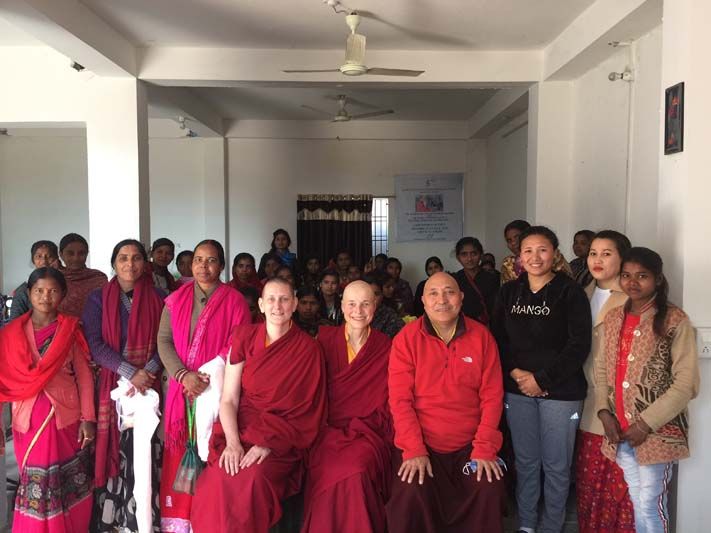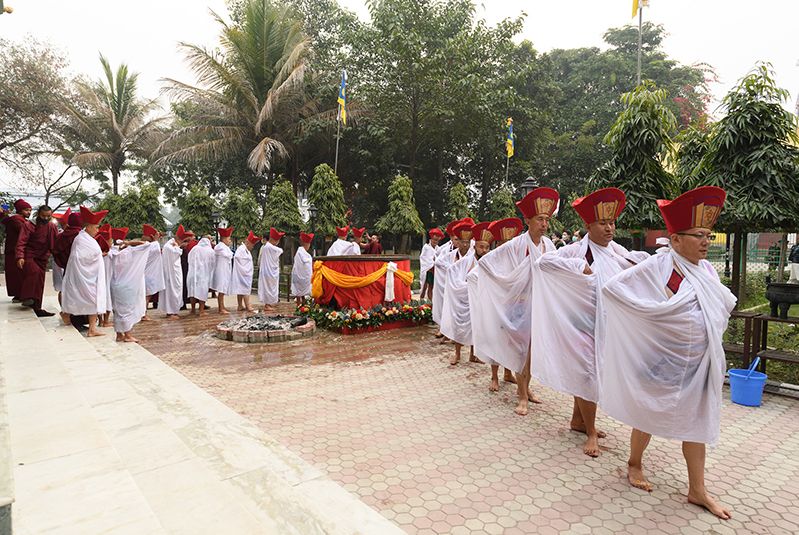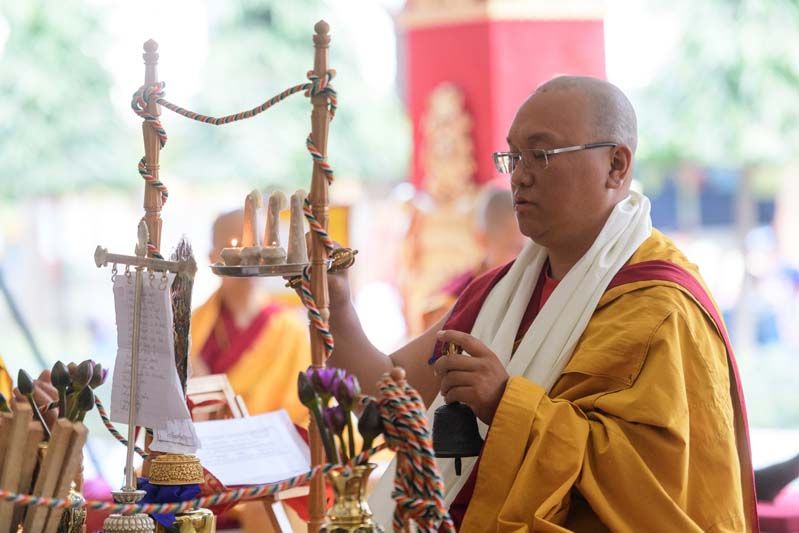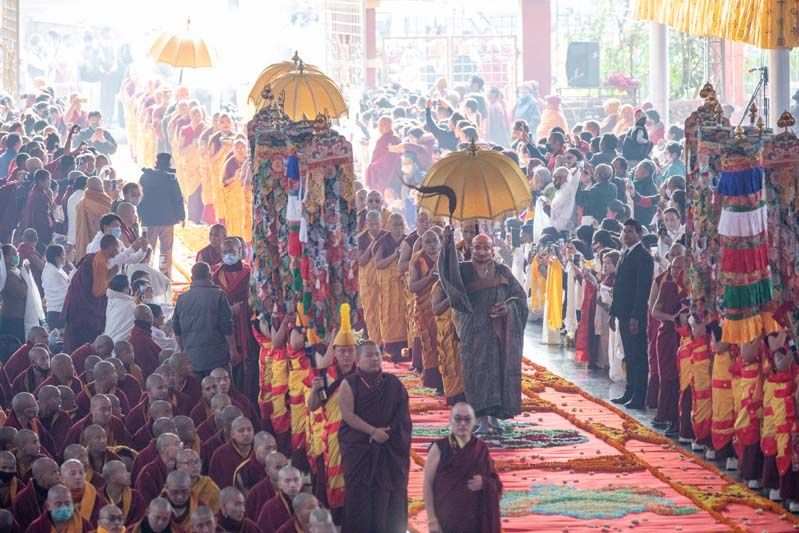Yongey Mingyur Rinpoche on the Four Foundations of Mindfulness Session 5: Liberating ourselves from suffering
- January 29, 2020

Monlam Pavillion,
January 29, 2020
Question and answer
People were still trickling into the Monlam Pavillion as the second session of the morning began so Mingyur Rinpoche opened the floor to questions.
The first question by one of the monks in the audience was “Why is Rinpoche asking us to close our eyes while meditating when in the texts we are told to open them and look up or in front?”
In response, Mingyur Rinpoche said: Generally, there are two different types of meditation. With shamatha, especially in the beginning, if you close your eyes it is easier for the mind to settle down, and it is said, the awareness becomes even clearer. When you have a little more experience and your experience becomes more profound, if it’s easier for you to close your eyes that’s fine, if it’s easier to open your eyes, that’s better. If you meditate with open eyes, you should look slightly down in front of you. Basically, you should be able to just see the base of the tip of your nose and mouth, but not look directly at them. It’s just that when you look down you can see your nose, especially if you have a big one. So there is no need to be very tight about this. There is also the method of looking up instead, just slightly up, not really high. You shouldn’t have your eyes wide open, and you shouldn’t squint.
Next, a monk asked a question regarding sitting down to meditate. You have the intention to do so and a real feeling that you are going to do it, but when you sit down, the body does not really feel like doing it or you are not doing anything at all. What’s happening?
Mingyur Rinpoche explained that generally, there are both high and low experiences. Or another way to express this is that there are harsh experiences and pleasant experiences. There are clear experiences where everything is clear and bright, like there are no clouds in the sky. There is the experience of non-conception: you feel like you have no breath or there is no feeling in your body, and you don’t have any thoughts in your mind—all coarse thoughts are pacified. When you have a harsh experience, there is agitation: lots of thoughts arise and it gets worse and worse. However, when we have this feeling that there are more and more thoughts, it’s actually a good sign. The reason is that it’s like water flowing down a steep mountain. In the second stage, it is like water flowing through the plain and in the last one it is like the ocean. You feel like there are never any waves.
At the first stage it feels as if there are even more thoughts than before. You feel like the situation grows worse when you meditate, but you need to recognise that’s actually a good sign. In the summer river water looks like mud; it looks like tea. You can’t see the fish or stones in the water. But in the winter it becomes clear and you see everything. Similarly, when you meditate, gradually you will begin to see all your afflictions. When we begin to practise the four foundations of mindfulness, our mind is usually so bound by all the thoughts and the afflictions. They are all mixed up in there. But when we look at the mind with awareness, that awareness becomes vaster than the thoughts and afflictions.
Rinpoche continued with a further analogy. When looking at a movie we are not in the film. Or it’s like looking at a mountain from a viewing site. When you look at the feelings with awareness then naturally you are no longer within the feelings. You are not bound up within them and are able to gain some control over your mind. Your mind becomes very clear. At the beginning, though, it feels like it becomes worse and worse.
Then we have experiences of dullness and torpor, becoming dull and then becoming duller and duller, until everything becomes blank. It can be like you are beginning to fall asleep. When you begin to meditate, it’s like that. So you think, what is happening today? At the moment I begin meditation, I begin to fall asleep. So that happens too. There are many different experiences. When they happen they are all good. For example, when we go from Kham to Lhasa we have to go up over the pass and then we have to go down. We are constantly going up and down, up over one pass and then back down, up again, at the top, and down again. But each time we are getting closer to Lhasa.
When we start on the lesser path of accumulation our experience is like that at the beginning. Then we progress from the lesser path to the middling path to the greater path of accumulation, and eventually we will reach the path of no more learning, which is Buddhahood. Whether we go up or down we are getting closer to Lhasa. Meditation practice is the same.
The third questioner asked, “How can we focus on feelings when so many arise? “
Mingyur Rinpoche explained that it’s good if there are many different feelings —it’s a sign that they are impermanent. However, as they change, we should not try to hold on to them. It’s not like a weasel that’s caught a mouse. Whatever feelings arise is impermanent, so as they arise, awareness needs to change.
However, there is one crucial point. Sometimes there are really strong, overwhelming feelings, such as the panic attacks that Rinpoche suffered when he was young, or depression and disappointment. Some people have really bad tempers. They have a lot of anger. The moment they go outside they lose their temper. Some people are really envious or jealous, desirous. So if you have these great afflictions there is a strong emotion that accompanies them. When you are looking at the feelings [in meditation] the feeling can be too strong and you aren’t able to direct your attention towards it. If this is the case, you need to shift your focus to something else. In order to move it, you should you should focus your attention on the breath and rest like that for a while, and, then when the feeling decreases, you can look at it again.
The final question was when practicing mindfulness of the body, when meditating on the breath it seems as if we are looking at the mind as something separate. Is that good? Is that correct?
Mingyur Rinpoche explained that when looking at any object, we are not inside the object, we are outside. When looking at the river, we are not in the water. We don’t need to stop the flow of the river; because we are not in the river we cannot be carried away by the water. But, normally, when we experience the afflictions, we are carried away by them. We fall in the river and are swept away. In contrast, if you can see the river, you are outside of the river. Similarly, when talking about the mind and breath, that becomes the indivisible mind and breath—this feeling of being out of it that naturally happens.
After the final question Rinpoche tested the participants. He asked how many looked at their feelings or watched their breath during the break. He stressed that practicing during the breaks is really important. You can meditate anywhere, anytime. You don’t need to sit silently in the seven-point posture to practice. You can do the meditation when you are eating, or when you are speaking. You can do the meditation for a very short time, just for a couple of seconds. But you should do this repeatedly, over one or two months. A big empty bowl left to catch drops of water will eventually be filled with water. Similarly, when we practice us do it for short times repeatedly, then the stages and experiences will gradually arise. So it is important to do the practice during the breaks as well.
Continuation of the foundation of the mindfulness of feeling
This morning we talked primarily about the mindfulness of feelings and body, and the impermanence of the body. We rested on the impermanence of the body. We watched the breath in the lungs, the heart and the circulation of the blood, and the breath as it spread through the body. And at the end down to even the movement of the particles, if you think they are changing and if you rest in that way you are meditating on mindfulness of the body. This is the insight meditation on impermanence that is in common with the Foundation vehicle.
We also spoke of the foundation of mindfulness of feeling, the specific and the universal characteristics of knowing and feeling the sensation as you experience it. That is focusing on specific characteristics of the feelings. In terms of the universal characteristics you can meditate on the feelings as being impermanent. But in particular if we understand feelings are the of the nature of suffering, it is easy to understand the nature of suffering by way of feelings.
With the body it is easy to understand impermanence because the body is changing. You see that everything is changing. With the feelings it is easy to see that they are of the nature of suffering when we are practicing the specific characteristics.
What is the nature of suffering and of the unpleasant feelings? Generally there are three categories of feeling: pleasant, unpleasant, and neutral. A pleasant feeling is seeing momos and is really happy. An unpleasant feeling is seeing a dog stealing your momos. Thus, there is a basis for pleasant and unpleasant feeling. The neutral feeling is a subtle feeling and is difficult for us to realize it immediately.
All of these feelings are suffering by nature. The pleasant feeling is the suffering of change, the unpleasant feeling is the suffering of suffering and the neutral feeling is the suffering of formation. But all three feelings are suffering by nature.
The neutral feeling is difficult to recognise. Yet our entire body is permeated by it and it is always present. It’s that something is not quite right feeling, not quite stable. Or we are hoping to get something. Everyone has that feeling. This third feeling is the feeling that has attachment—recognizing the nature and grasping at it as being single, impermanent and autonomous, or the idea of good, bad or suffering.
After a short meditation on feeling, Rinpoche continued to elaborate. The subtle feeling is the basis of suffering. You think I need this, I need that, and I need to get a better one. This is dissatisfaction or disappointment. This is what we call dukgnal. The real meaning of suffering is dissatisfaction, not being content. When the power of that bubbles up, whether we are eating momos, looking at our phones, etc we get bored. We think, “I need something.” If we look at our phones too much then a different feeling arises. “Maybe I should go look at a movie with my friends. Or have a meal.”
Even though we don’t want suffering, we rush after it to our own ruin. We destroy our own happiness like a foe. The cause to achieve happiness is virtue. What we want is happiness, but we run after the causes of suffering. It is like we whack ourselves with a hammer and then look around and ask who did that to me. The main cause of this is ignorance. We don’t know the true nature of the object. We have the three poisons of hatred, anger and delusion and because of that we accumulate karma and suffering. In order to pacify that we need to look at the true nature of ignorance and that will liberate us from suffering. Gradually things will become clearer and clearer and we become closer to insight meditation.
We don’t need to block or create any feelings. The point is prajna, that awareness that arises as prajna, and then naturally the sufferings and afflictions will be pacified. We don’t need to stop the feelings. We need to just look at them. When we have the fire of prajna then everything that doesn’t accord with the nature of the object is burnt away.
The foundation of the mindfulness of mind
After a short meditation on the mindfulness of feelings Rinpoche began to discuss the mindfulness of mind. The foundation of mindfulness of mind is also meditated in terms of the two different stages of specific and universal characteristics. The specific characteristic is mind means the focus, the focus on an object, knowing an object or clear and aware. When you know that as it is then that becomes the foundation of mindfulness. Resting on the object as it is mindfulness of mind.
In order to achieve the insight of the Mahayana we first need to achieve the Foundation vehicle. For example, when we do the ngondro practices we need to do the four thoughts that turn the mind. If we do not meditate on those well, we will not practice as well as possible. As it is said, the preliminaries are more important than the main practice.
These foundations are always there but we need to put them into practice and meditate on them, otherwise they are just empty words. If they become empty words, then even if we study for many years, we will be unable to pacify the suffering and afflictions in our mind, and, instead of helping others, we will think, “There is nothing else that I need to study.” We will criticise others because our understanding is limited. It is often said that wicked people can be tamed by dharma, but people who have mistaken ideas of the Dharma are difficult to tame because they have such misunderstandings they don’t see it within themselves, and so are unable to pacify their minds.
Rinpoche posed a question, “What is the characteristic of mind?” The reply was that it is clear and aware. “What is the characteristic of cognition?” The reply was awareness of an object. Clear and aware, and focus on an object are all mind.
Then Rinpoche asked, “Do you have thoughts?
The main point of the foundation of mindfulness is that whatever the object of mindfulness is we rest with that. As is said in Mahamudra, “Non-distraction is the main practice of meditation. Whatever arises just resting naturally without changing.” So whatever arises, whether it is good, bad or neutral, whatever happens , we rest in the nature of thought —“The fresh essence of thought”—without altering it.
There followed a short meditation: Look at your thoughts, whatever is appearing in your mind, just look at it with your awareness.
Rinpoche explained that one possible outcome was that when you looked at your thoughts, they disappeared. When doing mindfulness of mind meditation you need thoughts. If you can’t find any, you need to create thoughts and then look at them. When you forget to look at the thought, you fall under its control but if you can maintain awareness this won’t happen.
Then Rinpoche shared a secret. When you look at thoughts there are two experiences you can have. That is the secret. The first experience is when you look at the thought you lose the thought. The second experience is the thoughts occur. If you rest in them appearing, the thought itself becomes the support, the basis of meditation if you are looking at it.
The first experience is that you are looking at a thought and it disappears. It’s like when you are waiting for the bus and it comes. Then it leaves very quickly, leaving you behind. The second experience is like the river. There are many thoughts arising. You just look at them undistracted. You can also look at afflictions. If you can look at the afflictions, you are not overcome by them and the power of the afflictions automatically becomes pacified, because afflictions are just projections of our mind. When you are able to look at thoughts and afflictions with awareness, they lose their power over you.
After Rinpoche had dedicated any merit accrued to all sentient beings, so they might receive the benefit of dharma and be free from all illnesses and suffering, achieving the state of Buddhahood, the session concluded with The Mahamudra Prayer of Definitive Meaning and The Aspiration Prayer for the Well –Being of Tibet.

37th Kagyu Monlam Schedule
Tibetan / English / Chinese • French • German • Indonesian • Korean • Polish • Russian • Spanish • Vietnamese
Dharma Teachings
 Meditation Instructions
Meditation Instructions
Recorded during the 37th Kagyu Monlam, Bodhgaya, India. January 28-30, 2020.
